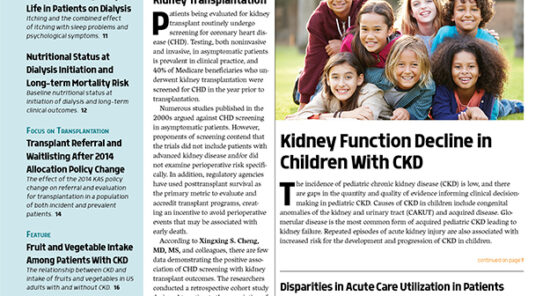Credit: Original article published here.Sodium-glucose transport protein 2 (SGLT2) inhibitors (SGLT2i), or gliflozins, block SGLT2 cotransporters in the proximal tubules and reduce renal glucose and sodium reabsorption.1 Reduced reabsorption of sodium results in natriuresis, which, through tubuloglomerular feedback, causes a reduction of intraglomerular pressure. SGLT2i have been shown to not only slow kidney progression in patients with chronic kidney disease regardless of diabetes status, but also improve glucose control, reduce the risk of heart failure, and reduce blood pressure, and they do so in a cost-effective manner.2 The use of SGLT2i has been limited despite approval in the United States since 2013 (canagliflozin). One important factor, which research suggests might be a myth, is that underutilization of SGLT2i therapy is due to their high cost or high copayments. Two recent studies have reported on utilization of SGLT2i where cost was not a factor, namely the US Department of Veterans Affairs (VA), where prescriptions are free. The first study by Mahtta et al looked at SGLT2i use in 537,980 patients with atherosclerotic cardiovascular disease (ASCVD) and type 2 diabetes mellitus (T2DM) in 130 VA facilities.3 They reported that approximately 11% of patients were on SGLT2i therapy. Surprisingly, among individuals with an
Credit: Original article published here.Patients being evaluated for kidney transplant routinely undergo screening for coronary heart disease (CHD). Testing, both noninvasive and invasive, in asymptomatic patients is prevalent in clinical practice, and 40% of Medicare beneficiaries who underwent kidney transplantation were screened for CHD in the year prior to transplantation. Numerous studies published in the 2000s argued against CHD screening in asymptomatic patients. However, proponents of screening contend that the trials did not include patients with advanced kidney disease and/or did not examine perioperative risk specifically. In addition, regulatory agencies have used posttransplant survival as the primary metric to evaluate and accredit transplant programs, creating an incentive to avoid perioperative events that may be associated with early death. According to Xingxing S. Cheng, MD, MS, and colleagues, there are few data demonstrating the positive association of CHD screening with kidney transplant outcomes. The researchers conducted a retrospective cohort study designed to estimate the association of pretransplant CHD testing with rates of death and myocardial infarction (MI). Results were reported online in JAMA Internal Medicine [doi:10.1001/jamainternmed.2022.6069]. The study included all adult, first-time kidney transplant recipients from January 2000 through December 2014 in the US Renal Data System. Eligible patients had at
Credit: Original article published here.Currently in the United States there are more than 500,000 patients with kidney failure on dialysis. The preferred treatment for kidney failure is kidney transplantation. Compared with dialysis, transplantation is associated with longer survival, better quality of life, and fewer hospitalizations. There are national policy directives for dialysis facilities designed to maximize access to transplantation and incentivize waitlisting. However, according to Rachel E. Patzer, PhD, MPH, and colleagues, only ~18.5% of patients with kidney failure are on the transplant waitlist. Further, there is significant variation in access to the waitlist and subsequent transplant. In December 2014, the United Network for Organ Sharing (UNOS) Organ Procurement and Transplantation Network (OPTN) implemented a policy that has had substantial impact on the way kidneys are allocated. Improvement in transplantation access equity was a major goal of the new kidney allocation system (KAS). The primary determinant of priority for organ allocation is allocation time. The new system changed the start of the allocation time from the date of waitlisting to the date of dialysis initiation (with the exception for pre-emptively waitlisted patients). Since the implementation of KAS, waitlisting has declined. It is unknown whether the decline was due to a
Credit: Original article published here.From the Field You read that right. The Medicare cost report that dialysis facilities submit each year can be an opportunity to capture revenue for certain bad debts. At a time when costs to run a dialysis facility are outpacing revenue, maximizing every available revenue source is more important than ever. With that in mind, I thought it would be helpful to provide some basic information about the dialysis facility cost report for those who are new to the renal industry or newly responsible for their facility’s Medicare cost report. The current form used to submit a cost report for freestanding dialysis facilities is the CMS-265-11. The Centers for Medicare & Medicaid Services (CMS) uses the cost report to gather data on treatment counts across all modalities, medication and supply utilization, costs to provide treatment and run the dialysis facility, as well as revenue and uncollected bad debt. If you are a dialysis facility administrator, you are likely familiar with collecting this information each year to pass on to whomever prepares your cost report. Filing a cost report could be likened to filing taxes; both are complex, can have serious financial and legal implications if done





